

Vol. 38 (Nº 49) Year 2017. Page 30
Natalia KRYLASOVA 1; Andrei BELAVIN 2; Yulia PODOSENOVA 3
Received: 30/09/2017 • Approved: 05/10/2017
2. Data, Analysis, and Results
3. Representation of process technology features of bone-carved artifact crafting of Perm Cis-Urals
ABSTRACT: Bone carving has been an important part of medieval production due to availability and cheapness of production materials. Bone-carved artifacts are of all kind: from household items to weapons. This article is devoted to bone carving in Perm Cis-Urals in the Middle Ages. To achieve this goal we used complementary research methods such as analysis, historical-logical, analytical, historical-cultural research methods. This article also provides generalization of national and international experience on the issue of research. Bone carving comprehensive analysis in Perm Cis-Ural region showed that bone-carved artifacts were mostly homemade and were technologically low. However, professionally oriented artisans only began to appear, who passed manufacturing technology from generation to generation. Bone artifact presence on the territory of Perm Cis-Ural region made in Kievan Rus indicates their turnover and economic relations with Europe. This article may be theoretical source for further research of Finno-Ugric culture. |
RESUMEN: La talla de hueso ha sido una parte importante de la producción medieval debido a la disponibilidad y baratura de los materiales de producción. Los artefactos tallados en hueso son de todo tipo: desde objetos domésticos hasta armas. Este artículo está dedicado a la talla ósea en Perm Cis-Urales en la Edad Media. Para lograr este objetivo se utilizaron métodos de investigación complementarios como análisis, métodos de investigación histórico-lógicos, analíticos, histórico-culturales. Este artículo también proporciona la generalización de la experiencia nacional e internacional sobre la cuestión de la investigación. El análisis detallado de talla de hueso en la región Cis-Ural de Perm mostró que los artefactos tallados en hueso eran en su mayoría hechos en casa y eran tecnológicamente bajos. Sin embargo, los artesanos profesionalmente orientados solamente comenzaron a aparecer, que pasaron la tecnología de fabricación de generación en generación. La presencia de artefactos óseos en el territorio de la región Cis-Ural de Perm hecha en Rus de Kievan indica su volumen de negocios y relaciones económicas con Europa. Este artículo puede ser fuente teórica para la investigación adicional de la cultura Finno-Ugric. |
As practice shows, the study of ancient artisan production in certain areas makes it possible to obtain information contributing to solving a variety of problems far beyond the problems associated with handicraft (Libakova, 2015; MacGregor, 2014; Waechter, 2013). Such information has a number of unique features and attributes that make it a valuable historical source not only in describing life and daily activities of people in a certain period, but also a valuable historical source in solving fundamental problems. They are historical-genetic roots definition in forming a certain ethno-cultural environment, local and ethnic characteristics of people, migration and integration of ethnic and cultural processes depending on adjustment in learning natural and geographical space, economic and social development level of ancient society, chronology of ancientries (Almukhambetov, et al., 2016; Toropova, Gadzhieva & Malukhova, 2016; Fischer & Herrmann, 2013). Such research is particularly relevant in areas, where there are no written historical sources to characterize certain era and the main sources are materials of archaeological research. One of such areas in the territory of Perm Cis-Ural region of the Middle Ages. This study is focused on comprehensive research results introduction in science related to bone carving in Perm Cis-Urals in the Middle Ages. Perm Cis-Ural region is a vast geographical area within the modern Perm Krai located on the western slopes of the Middle and Northern Urals at the junction of two continents – Europe and Asia. In the Middle Ages (V-XV centuries), Perm Cis-Urals had two archaeological cultures – Lomovatov (V-XI centuries) and Rodanov (XI-XV centuries) (Belavin & Krylasova, 2002).
This research is based on a complex study of bone-carved artifacts of various archaeological sites: Lomovatov and Rodanov archaeological cultures to reconstruct bone-carving process from raw material selection stage to crafting and product use. The complex nature of the research involves a comprehensive study of objects (evidence of bone carving) and events (study of bone carving a system of daily living). Comprehensive study of sources on bone carving (bone-carved artifacts and tools for bone carving) was carried out by wide range of learning methods (analysis, synthesis, cause-and-effect relationships, etc.), traditional methods of archeology (typology and classification, quantitative analysis, cartography, method of analogies, etc.), as well as natural science methods used archaeological science. The last are paleoosteological analysis of bone-carved artifacts (to find bone belonging to a certain type of animals or birds and to study bone material properties of a particular animal) trace evidence method (trace study of process steps in crafting bone-carved artifacts), experimental method (to confirm conclusions).
Views research history of bone-carved artifacts
In medieval society, bone-carved artifacts were important as household instruments due to raw material availability and ease crafting process. A large range of created artifacts confirms raw material flexibility: cutlery, household products, farming tools and weapons.
In addition to large animal population, bone carving in Perm Cis-Urals was popular due to financial cheapness and practicability.
The first publication of bone and horn findings originating from Perm province appeared in an illustrated work of pre-revolutionary researcher Spitsyn (1902). Then, articles and publications appear only in 50-80 years of XX century. They partly provided attributes and classification of some artifacts made of bone and horn (Goldina, 1985; Oborin, 1956; Oborin, 1995).
In these publications, bone-carved findings correspond to a specific category of artifacts and are described briefly. In describing medieval culture of Komi-Perm people, Oborin noted a special role of bone artifacts in the economy. He also was first to allocate a category of bone-carved artifacts intended for a dog or reindeer harness (Oborin, 1956). In another work, he provides cultural and chronological attribution of knife hilt made of animal horn found at the Anyushkar settlement of Rodanov archaeological culture (Talitsky, 1951).
At the end of XX - XXI century, the interest in artifacts of bone and horn originating from medieval sites of Perm Cis-Urals increased. There are works devoted to unique and interesting artifacts of bone and horn, overviews of bone carving development in Perm Cis-Urals, bone-carved artifacts classification and works on decoration methods. Belavin in "Kama trade route" allocated borrowed bone-carved artifacts – Bulgarian and Old Russian (Belavin, 2000). Several scientific studies provided description of costume bone-carved elements and ornaments of medieval Kama population (Krylasova, 2001). Part of her publications was focused on individual unique bone-carved finds found during field surveys of various medieval archaeological sites in Perm Cis-Urals (Krylasova, 2012; Krylasova, 2013). Lenz proposed classification and attribution of artifacts made of bone and horn of Rodanov archaeological culture by describing artifacts originating from Anyushkar settlement. He also provided a brief characterization of bone-carved artifact existence in Perm Cis-Urals since the early Iron Age (Lenz, 1999; Lenz, 2002). Mavrina considered medieval artifact ornamentation of bone and horn from medieval sites of Perm Cis-Urals on the example of accessories and jewelry (Mavrina, 2015).
Thus, there was no separate research dedicated to bone-carved artifact characterization of Perm Cis-Urals in the Middle Ages (V-XV centuries). Hence, this article extends historical and cultural knowledge of the region.
Raw materials for bone carving in Perm Cis-Ural region in the Middle Ages
Bone and horn treatment, as well as treatment of metal and clay, should be considered as the most ancient technological tradition of humanity. Its formation and development had a long and difficult path of evolution with a variety of traditions at the end reflecting historical development of material culture in the local parts of the world at different times. Any aspect of handicraft should be considered by taking into account the economy specificity and geographical location of the area.
Lomovatov and Rodanov archaeological sites of Perm Cis-Urals were located in the forest area. Natural environment of Perm Cis-Urals in the Middle Ages was quite harsh, but favorable for agriculture. Cattle farming also had a greater role in the economy of local tribes, namely in the form of horse breeding, cattle breeding and sheep raising. Researchers believe that there could also be not herd reindeer raising in the northern areas.
Hunting for wild animals and birds were also of particular importance along with agriculture and cattle farming. Fauna of Perm Cis-Ural region in the Middle Ages (and nowadays) was mixed: elks, wild boars, reindeers and Siberian roe deers. Brown bears, wolves, foxes and various weasels represent predators. On the banks of rivers, there were otters and beavers; in the forests – lynxes and wolverines, squirrels, chipmunks, rabbits. There were many birds, including migrating ones. Fishery was as important as hunting was. Rivers of Perm Cis-Ural region in the Middle Ages had major commercial stocks of fish (42 species), including salmon (in the northern rivers of Perm Cis-Urals), Kama salmon and Caspian migratory sturgeon.
Thus, hunting and cattle farming gave medieval inhabitants of Perm Cis-Urals all the raw materials to develop bone carving. Mass bone-carved artifacts find during archaeological field surveys at Rozhdestvenskoye settlement in 2010-2014 were examined by paleozoological method (determination of bone material belonging to certain animal species, birds or fish). Paleozoological determination was also carried out for bone-carved artifacts of Anyushkar settlement. Research was carried out by Kosintzev, a senior researcher, PhD in Biology, at the Institute of Plant and Animal Ecology, Ural Branch of the Russian Academy of Sciences.
The results showed that the vast majority of artifacts both at Rozhdestvenskoye settlement (X-XIII centuries) and at Anyushkar settlement (XI-XIV centuries) were made of tubular bones –metapodia of horse and elk, less often – reindeer and large cattle (Smirnov, 2014). There were also used ribs and scapula of cows, horses, moose, slate bones of cows, horses and elk, sesamoid bones of a horse, shin bones of marten, epiphyses of horses and cattle, pasterns of s horse, sheep and pigs, as well as fangs and teeth of wild and domestic animals. Bones of small cattle (goats) were in use rarely, as well as beaver hucklebones. One of amulets from Rozhdestvenskoye settlement (2010 year) was made of wolverine’s os penis.
Artifacts made of fish bones and bird bones are less common. Fish bone amulets and objects (needles) required vertebrae and rib bones of sturgeon. The bird bones were greyhen’s bones and duck’s ones.
Horn material was represented with horns of moose and reindeer, less often – of cattle (cows).
Thus, bone-carved artifacts were made mostly of bones of domestic animals (reindeer, horses, cattle) and elk. However, the choice of material depends not only on its availability, but also on process technology features and labor cost.
Researchers of bone carving note that treatment techniques of original bone material is similar to wood processing methods and can remain unchanged thought historical periods. Bone treatment techniques and craft methods may be identical at different sites of medieval oecumene (Oborin, 1995).
Horn treatment is the easiest material for crafting with minimum labor cost. Horn, unlike bone, is well cut and sawed. Its physical properties – softness, flexibility and strength – allow making different artifacts of large and small sizes. It is easy to perform carving on the horn material, to cut small parts of slotted ornament. Therefore, the horn was used primarily to craft artifacts requiring aesthetic perception.
The horn could be sawn or cut depending on artifact’s size and shape. Then, horn pieces ware cleaved into smaller plates or parts. If horns had porous inner fabric it is removed with a special tool – punches, chisels and wedges. These parts were cleaned with a knife (the rest dark outer parts of the horn), polished and ground with abrasive materials (sand, grass, stones with a rough surface). Then, the master could take any unfinished part and craft any item by cutting, sawing, cleaning.
Artifact crafting with animal bones was more time consuming process with a large number of operations. The bone has such physical characteristics as density, hardness and elasticity. On the one hand, these characteristics make bone treatment more complicated. On the other hand, these properties make the bone the most practical material for crafting artifacts for everyday necessities (stakers, arrowheads, weaving tools, prods). At the first stage the bone shall be cleaned from body fat and soften for subsequent operations. This is done by digestion in an alkaline solution. The bone is cut or sawed after initial defatting. Then, the parts are defatted again in the same solution. There goes the third digestion after the part were well shaped. The last digestion is after cutting a shape and before placing an ornament. The bones may be steamed or reheated while the ornament is being placed (if it was deep enough and the bone – dense).
Particular attention should be paid to methods of ornamentation, which can be divided into four groups:
carvings – performed with the cutting tool, possibly a knife;
circular ornament – performed with two or three-tooth special tool (compass with one supporting part);
slotted ornament – to cut an image on the item;
pounced ornament – performed with any sharp tool.
Carvings and circular ornament are the most widely used in bone-carved artifact decoration in Perm Cis-Urals. They are common for most categories of bone-carved artifacts. Slotted and pounced ornaments were less common. The first was used in crafting combs with zoomorphic back, the second – in decorating combs, hairbrushes, less often – awls.
Bone-carved artifacts found during field surveys at medieval archaeological sites in Perm Cis-Urals can be divided into mass and individual.
Mass bone-carved artifacts are tools for household production.
There are mostly weaving tools at medieval sites in Perm Cis-Urals (Figure 1). Weaving tools were used in weaving stuff from birch bark, living bark, bast, leather, wicker and thick threads. This is a tool in the form of a long pointed rod (16-20 cm) of different widths and different design. Weaving tools are made of ribs and fractured long bones of large animals. Many tools have a hole in the upper part or a “button” knop designed for the tool to be hung up. Original tools had an ornament in the form of an oblique lattice, zigzag, herringbone or point pinholes. Property signs or family signs – tamga – are rare.
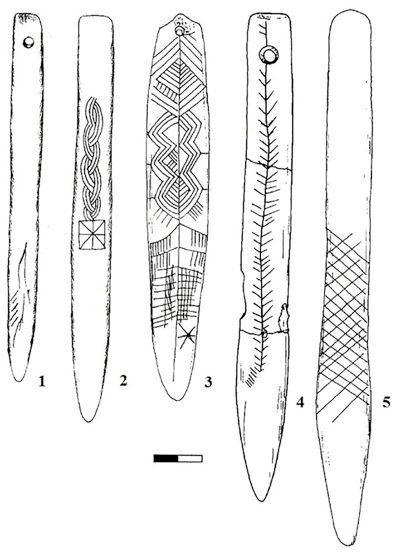
Figure 1
Weaving tools at medieval sites in Perm Cis-Urals (Krylasova authoring).
1,5 – Rozhdestvenskoye settlement; 2 – Anyushkar settlement;
3 – Maykar settlement; 4 – Telyachiy Brod barrow.
Tools for spinning and weaving are in a smaller number (Figure 2). These are widespread spindles – a bone disc with a hole in the middle. Spindle whorl put on the bottom or in the middle of a wooden spindle made it more rapid while threads twist. Bone spindles are found at the sites of VIII-XIV centuries (Figure 2). There are quite common bone beam-heddles and shuttles designed to hang heddle frame and to put a thread (settlement of XI-XIII centuries) (Figure 2) (Krylasova, 2001). During certain digs at the settlements and burial grounds, there were found bone needles with an eye designed for sewing (Figure 2). Medieval people in Perm Cis-Urals used bone needle cases to keep and carry needle. They were in the form of hollow rough bones of small animals and birds or in the form of a conical case with a lid bounded with a lace of fabric or leather thought a hole (Figure 2).
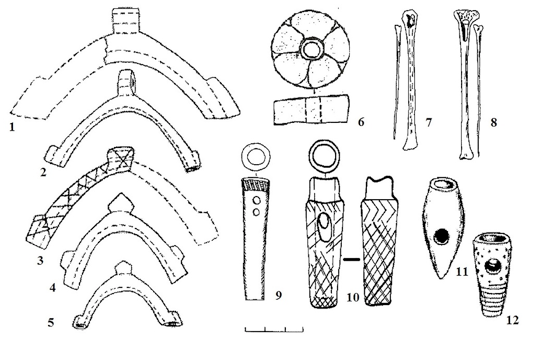
Figure 2
Tools for spinning and at medieval sites in Perm Cis-Urals (Krylasova authoring).
1-5 – «beam-heddles», 11,12 – shuttles, 6 – spindle whorl, 7,8 – needles,
9,10 – needle cases; 1 – Telyachiy Brod barrow; 2-4,6,7 – Anyushkar settlement;
5,8,11,12 – Rozhdestvenskoye settlement; 9 – Salomatovskoe settlement.
Tools for leather working are presented in a wide range: stakers for leather belts, prods, awls and polishers (Figure 3). Staker is a device to “pummel” leather belts made out of bones of large animals, mostly from metapodia of horses. The leather was stretched and soften by a simple friction in the middle of a bone. Therefore, the middle part of such artifacts is polished and erased, sometimes the artifact are found broken in this part during excavations (Figure 3). To soften narrow belts there were used drilled scapula of cattle. Prods were used to make holes in leather belts and fabric. They looked like a thin pointed rod made of slate bones of an elk, cow or horse. Polishers or spatula designed to press down a seam were made of rib bones of large animals (Figure 3).
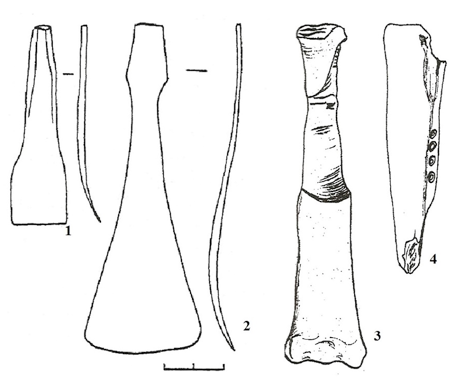
Figure 3
Tools for leather working at medieval sites in Perm Cis-Urals (Krylasova authoring).
1-2 – polisher, 3 – staker, 4 – bone plate with drills to soften leather belts 1-2,
4 – Anyushkar settlement; 3 – Rozhdestvenskoye settlement.
There are often found one-piece knife handles and ones made of many parts at archaeological sites of IX-XIV centuries, as well as handles and cases for awls (Figure 4).
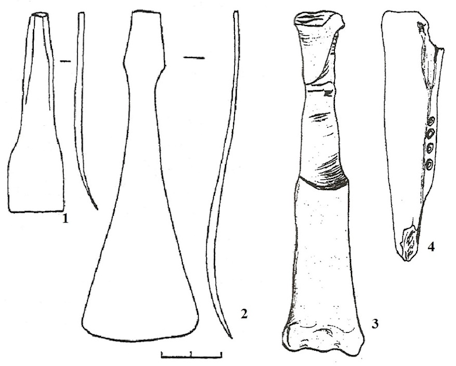
Figure 4
One-piece and combined knife handles, handles and cases for at medieval
sites in Perm Cis-Urals. 1 – knife handle, 2-7 – awl handle, 8 – combined knife handle part,
9 – awl case, 10 – guideline to carry awl and its case. 1,3,8,4,7,8 – Anyushkar settlement;
2 – Lavryatskoe settlement; 5 – Plyosinsky burial, 9 – Vakinsky burial; 6 – Kudymkar burial.
Knife handles were made of elf horn or deer horn, which shape is perfect for cylindrical artifacts. Combined knife handles (made of many parts) were found only in layers at Anyushkar settlement dating from XII-XIV centuries, consisting of two cylindrical parts carved on a lathe (Lenz, 2002).
Functional awl parts can be often found at archaeological sites. According to the researchers, an awl was popular in Finno-Ugric peoples and was not only a universal tool, but also an amulet in a men costume (Krylasova, 2012). Awl handles are "T"-shaped and drilled on the edges. Leather laces are hold through these drills for an awl to be hang up on a belt. Most awl handles have a pounced, circular and linear pattern. Grid pattern is rarely found (Figure 4). They all were made of elk antlers that also have a proper natural form for crafting. As a rule, awls carried on a belt were placed in special cylindrical horn-made cases with a conical inside cavity for sharp awl part. There were two knops with through-holes on the sides of the case in its upper part. Leather laces threaded into the holes bound the case and handle hung up it to the belt. The awl working part was removed by sliding the handle pulling the laces (Figure 4).
The predominant category of bone artefacts from medieval sites if Perm Cis-Urals involve weapons and hunting instruments (Figure 5). These are socketed and tanged arrowheads made of deer or elk horn (socketed) or solid tubular bones (metapodia) of a moose or a horse (tanged). Socketed arrowheads are artifacts with a cone-shaped cavity inside corresponding to the artifact shape; the shaft was inserted into an arrowhead. Socketed arrowheads are represented with bullet-shape arrowheads with a sharp point and Tomars – arrowheads with blunt tip to hunt for fur animals. Tanged arrowheads have a flat or square section at the base of the tip for arrowhead to be inserted or attached to the shaft. Tanged arrowheads are represented with various forms: bullet-shaped, keeled, sub-triangular, diamond, with multi-faced (from three to six) feather forms with one, two or three spikes.
Hunting instruments include bone-carved callers or whistles used in hunting for upland game (Figure 5).
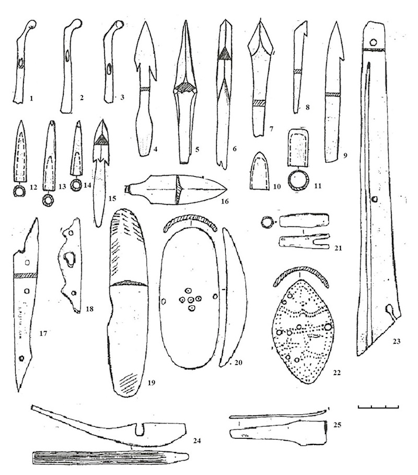
Figure 5
Weapons and hunting instruments made of bone and horn from Anyushkar
settlement (Lenz authoring). 1-3 – callers 4-16 – arrowheads, 17 –quivar loop,
18 – bowcase loop, 19,24,25 – lateral, medial and terminal plates a complex bow,
20,22 – left wrist safety shields; 21 – bowstring loop, 23 – bowcase plate.
Structural details of a composite bow made of animal bones are common at large settlement of Perm Cis-Urals (XI-XIV centuries). They include complex bow plates, loops for a bow and quiver, string hooks, wrist plates and quiver plates (Figure 5).
Significant category of artifacts involves bone-carved harness elements designed to use draft power of horses, dogs and deer. These elements are loops, long halters that are oval in cross-section wider in the middle, swivels for dogsledding, psalium, shackle parts, clasps in deer nosebands, dog-lead parts, stuff for attaching sleds (Figure 6 ).
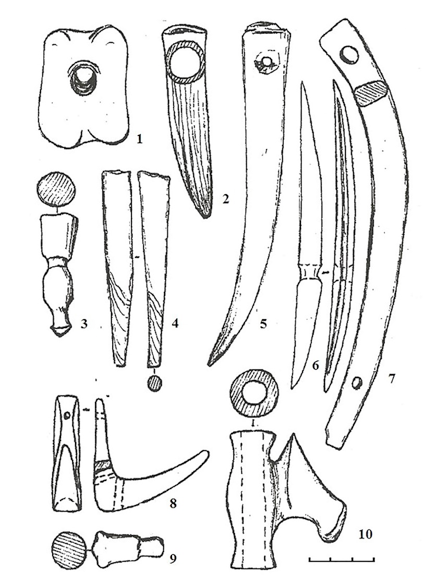
Figure 6
Bone-carved harness elements from Rozhdestvenskoye settlement and
Anyushkar settlement (Lenz and Krylasova authoring). 1 – swivels for dogsledding,
2 – dog-driver’s pole tip, 3,4,9 – water bottle cork, 5 – tool for unleashing knots,
6 – psalium, 7 – dog-lead, 8 – bowstring hook. 1-10 – Anyushkar settlement,
10 – Rozhdestvenskoye settlement.
As for household artifacts, there are bone-carved spoons, spoon and fork handles at Perm Cis-Ural sites (Figure 7). Kama used bone-carved spoons in everyday life during the IX-XIV centuries. Spoons are represented in various forms depending on their purpose. They are flattened with short handle and a dipper of different forms – sub-triangular, round and in a form of an elongated triangle; spoons with long handle with a relatively small dipper, perpendicular handle stretched along a line; spoons with oval egg-shaped dipper (Figure 7).
Spoon handles, less often – their dippers, were decorated with various ornaments: ornaments in the form of braids, geometric, linear, circular, rarely – floral. In some cases, spoon handles were cut under an animal – bear's head or head of a horse. There were also spoons with handles in the form of a dragon's head, but such artifacts were drawn from Kievan Rus [16] due to trade relations between two cultures. Kievan Rus provided bone-carved jewelry and aesthetic artifacts. Bone carving in Kievan Rus, in contrast to Perm Cis-Ural region, was borrowed from Western European and Byzantine cultures.
In addition to spoons, there were forks at medieval sites of Perm Cis-Urals in XII-XIV. However, they are relatively rare to find. Certain fork handles were made of bone as a cylindrical rod with cavity inside for iron forkhead to be placed (Figure 7).
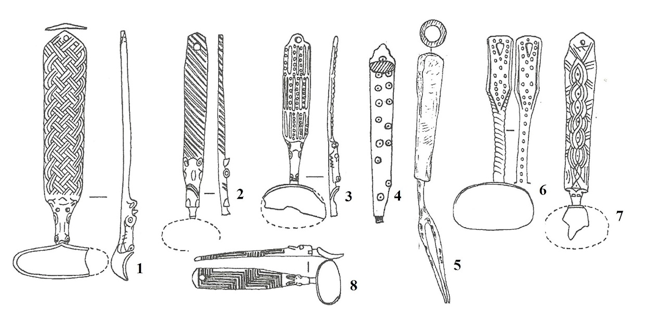
Figure 7
Bone-carved household artifacts at medieval sites in Perm Cis-Urals (Krylasova authoring).
1-3 – spoons, 4 – fork handle, 5 – fork, 6-8 – spoons. 1 – Kudymkarskoye settlement;
2, 5 – Gorodishenskoye settlement; 4 – Anyushkar settlement; 3, 6-8 – Rodanov settlement.
There are found many clothing accessories and jewelry made of bone and horn, fish bone at Perm Cis-Ural sites (Figure 8).
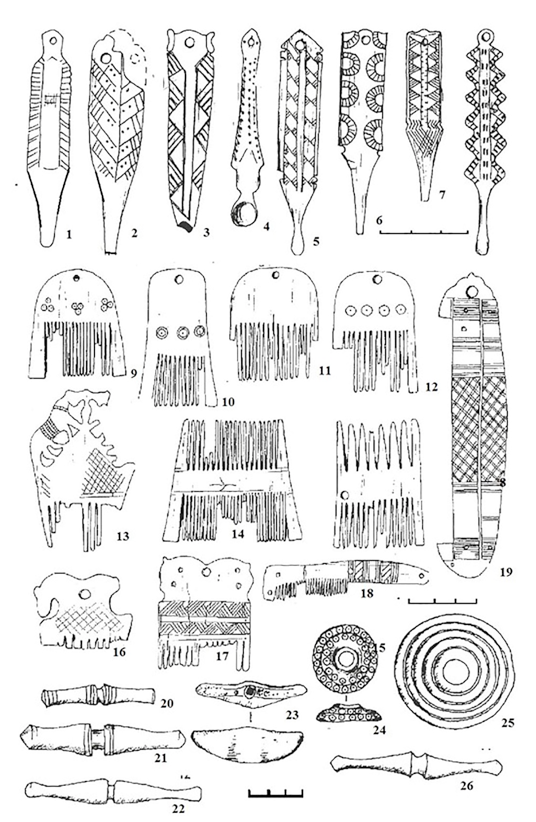
Figure 8
Bone-carved clothing accessories and jewelry at medieval sites in Perm Cis-Urals.
1-8 – ear picks, 9-19 – combs and hairbrushes, 20-22,26 – “clip” buttons,
24,25 – buttons, 23 – horse metacarpal button. 1,9-12,14,15,18,19,25 – Anyushkar settlement;
2,8 – Kudymkarskoye settlement;; 3 – Salomatovskoe settlement; 4,7 – Vakinsky burial;
5,22,24 – Rozhdestvenskoye settlement; 6,17,20,21,26 – Kanevskiy burial;
13 – Plyosinsky burial; 16 – Vazhgortsky burial.
Ear picks were common toilet articles in Perm Cis-Urals designed to clean ears. In most cases, they were like bone-carved rods (sometimes metal) with a small spoon at the end with holes for hanging up. Such artifacts were common among medieval population of Cis-Ural in IX-X centuries. Bone-carved ear picks were with geometric, grid, flake or circular pattern. The researchers note that they were not only utilitarian, but also magical – amulets (Mavrina, 2015).
Combs and hairbrushes are also common bone-carved toilet articles in medieval in Perm Cis-Urals. They were especially popular in VIII-XIII centuries. Combs were like elongated plate with a number of teeth on one or both sides. This category of artifacts is quite varied at medieval archaeological sites of Perm Cis-Urals. One-piece comb with one side and zoomorphic sculptural image on the back (a horse or elk) was made of flat horn plates. One-piece comb with one side and arched back with ornamentation was made of large animal bones. One-side comb ornamentation was quite diverse in the form of scales, grids, braids, alternate cross-hatched and concolorous triangles.
One-piece comb with both sides was like a rectangular plate or trapezoidal one with teeth on both sides. There was no ornamentation on such a comb or it was monotone (1-2 types of ornament) in the form of straight lines, dots or circular pattern.
Hairbrushes are artifacts looking like flat rectangular plates of 7-9 cm long with frequent thin teeth. Such hairbrushes were made of several horn parts. An embowed plate was placed on both sides of the back with bronze pins. Such hairbrushes were often applied with a case. Cases were made of four parts (two front side and two embowed outer plates) creating a gap for teeth. Metal pins put these parts together. The back of cases and hairbrushes were decorated with geometric, grid or circular pattern. These artifacts were widespread in Perm Cis-Urals in the XII-XIV centuries. However, there is a disagreement among researchers about the origin of these artifacts. Some researchers believe that such hairbrushes could be made on the territory of Perm Cis-Urals as imitation of drawn ones; other researchers believe that they are borrowed (Krylasova, 2013).
Bone-carved clothing accessories are represented with varied closures – buttons. Very simple buttons made of metacarpal bone of a horse were widely spread. These artifacts had no additional treatment, except that the center was drilled. “Clip” buttons are another kind of buttons with a bridge in the middle for tying. Anchor-shaped and hook-shaped details were designed to hang up stuff (scabbard, handbags, wallets, flints, etc.) on the belt by tying it to a loop or ring.
Different amulets were made of animal fangs and jaws. Amulets of jaws of small predators with a drilled hole are the most common. Drilled fangs and claws of a bear, sable, badger, wolverine, marten and beaver’s astragalus were also used for amulets.
There is also many beads made of cartilaginous fish vertebra. They were used to make necklaces, these beads were part of pendants or necklaces with other beads made of bronze and glass.
There are bone0carved artifacts that belong to a small category of toys and entertainment: thunder stick as drilled phalanx of the animal; "alchiks" or dice for knuckles made of cattle astragalus and horn hatchets (Figure 9).
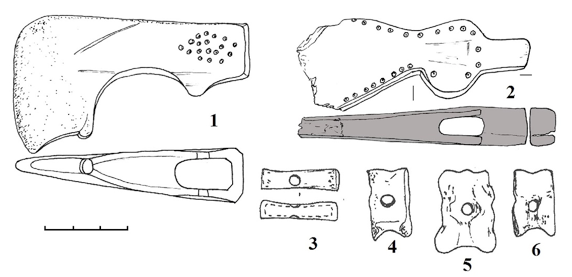
Figure 9.
Bone-carved toys at medieval sites in Perm Cis-Urals. 1,2 – hatchet,
3 – thunder stick, 4-6 – dice for knuckles. 1-6 – Rozhdestvenskoye settlement.
Thus, bone-carved artifact analysis of different timeline of Perm Cis-Urals in the Middle Ages shows high bone carving development and its universality in the life of society of that era.
Bone-carved artifact appeared in the Middle Ages in VIII-XIV centuries. However, the mass distribution was in X-XII centuries. There are two process technologies for raw material treatment found.
The first technology was developed within the framework of household production. Master-carver had a full knowledge about bone material: he knew how to carve a bone, defat it, digest and steam. However, there began to appear master that crafted aesthetically-beautiful things for sale. Their process technology was a secret and passed to younger generation. Such artifacts are well improvement, made of well-worked parts, same-type with clearly repeating predetermined shape. This is an artisan technique – one certain master created artifacts to order.
However, most artifacts characterize the second technology. They are crude; their parts were not finished, it is impossible to find "similar" artifacts among them. This is household technology – artifacts were made because of everyday necessities; everyone could cut a simple thing from digested bones having a knife if it was necessary.
Most likely, there appeared first bone carving workshops in addition to masters of small settlements and "household masters" on the territory of Perm Cis-Ural region in the X century. As evidence there were found same-type artifacts during digs at ancient settlements, frequent finds of instruments that were used to treat bones. Currently, these workshops have been found at Rozhdestvenskoye settlement and Anyushkar settlement.
The research has been conducted within the framework of Complex Program of Ural Branch of the Russian Academy of Sciences No. 15-10-6-29 «Perm Region and the Russian North" and the research work "Handicraft in the Perm Cis-Ural Region in the Middle Ages" in accordance with the document of the Ministry of Education No. 33.1091.2014 / On scientific research in the framework of state task project part in the field of science.
Almukhambetov BA, Nebessayeva ZhO, Smanova AS, Kakimova LS, Musakulov KT, Sydykova RS (2016) Making Art Pedagogy in the System of Education in the Republic of Kazakhstan. International Journal of Environmental and Science Education 11(18): 11341-11350.
Belavin AM (2000) Kama trade route. Perm: Perm State Humanitarian Pedagogical University Publishing, 200.
Belavin AM, Krylasova NB (2002) On the problem of medieval archeology periodization in Perm Cis-Ural region. Archaeology in Perm Cis-Ural Region: Textbook. Perm: Perm State Humanitarian Pedagogical University Publishing, 129-131.
Fischer PM, Herrmann G (2013) A carved bone object from Tell Abu al-Kharaz in Jordan: a Palestinian workshop for bone and ivory? Levant.
Goldina RD (1985) Lomovatov culture in the Upper Kama region. Irkutsk.
Krylasova NB (2001) History of Kama costume. Perm: Perm State Humanitarian Pedagogical University Publishing, 260.
Krylasova NB (2012) Medieval Amulet Illustrating the Divine Horseman Myth, Rozhdestveno, Perm Territory. Journal of Archaeology, Ethnology & Anthropology of Eurasia 1(49): 58-61.
Krylasova NB (2013) Horn hatchets from Rozhdestvenskoye settlement. Journal of Russian archeology 3: 125-128.
Lenz GT (1999) Bone-carving development of Komi-Perm people. Chelyabinsk: XIV Ural archaeological meeting, 171-172.
Lenz GT (2002) Bone carving in the Upper Kama region. Archaeology in Perm Cis-Ural Region: Textbook. Perm: Perm State Humanitarian Pedagogical University Publishing, 217-243.
Libakova NM (2015) Formation of Ethnic Identity of the Indigenous Peoples of the North in Arts and Crafts on the Example of Bone Carving.
MacGregor A (2014) Bone, antler, ivory and horn: the technology of skeletal materials since the Roman period. Routledge, 41.
Mavrina EK (2015) Specificity of Ornamentation of Bone Artifacts from Medieval Archeological Sites of the Perm Cis-Urals. Journal of Proceedings of the Kama archaeological and ethnographic expedition 10: 152-159.
Oborin VA (1956) On certain problems in studying Rodanov culture. Bulletin of Molotov State University 11(3): 85
Oborin VA (1995) Bone handle of Anyushkar settlement. Journal of Kratkiye soobshcheniya Instituta arkheologii - KSIA (Brief Communications of the Institute of Archaeology) 57: 133-134.
Smirnov NG (2014) The ecology of quaternary mammals in the Urals. Russian Journal of Ecology 6: 403.
Spitsyn AA (1902) Antiquities of Kama Chudes by Teploukhov’s collection. St. Petersburg, 189-194.
Talitsky MV (1951) Upper Kama region in the X-XIV centuries. Journal of Materialy i issledovaniia po arkheologii SSSR (Materials and Researches on the Archaeology of the USSR) 22: 33-96
Toropova AV, Gadzhieva ZSh, Malukhova FV (2016) Musicality: A Phenomenon of Nature, Culture, and Identity. IEJME-Mathematics Education 11(5): 1373-1382
Waechter J (2013) The beginning of civilization in the Middle East. Palestine Exploration Quarterly.
1. Ancient and medieval history of Russia, Perm state humanitarian-pedagogical University, Perm, Russia. E-mail: n.krylasova@mail.ru
2. Ancient and medieval history of Russia, Perm state humanitarian-pedagogical University, Perm, Russia
3. Science Department, Perm state humanitarian-pedagogical University, Perm, Russia